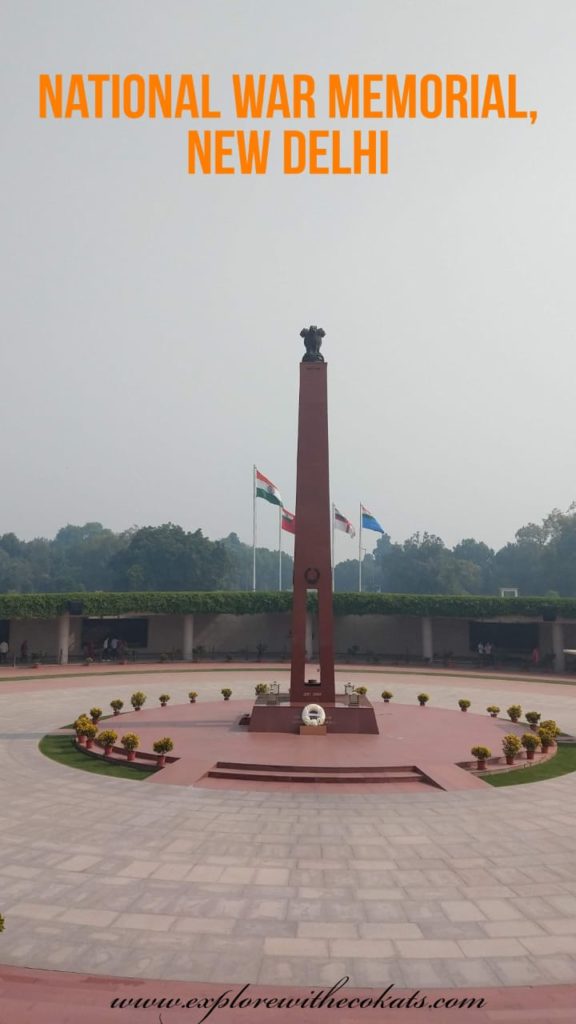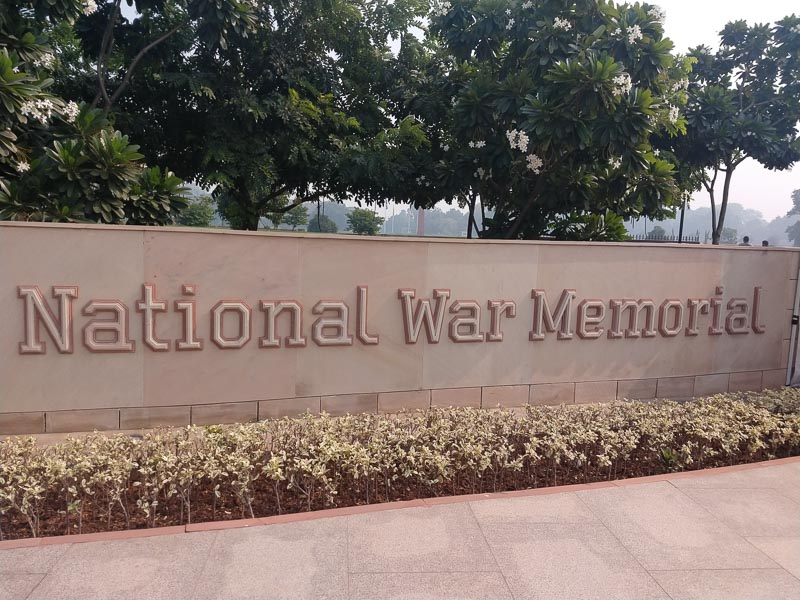Last Updated on March 11, 2023 by
When I was planning my trip to Delhi on Diwali last year, National War Memorial Delhi was one of the most looked forward to destinations to visit. And rightfully so! This memorial is spread over 40 acres in the India Gate, Delhi complex and visiting here is indeed one of the top things to do in Delhi.
Table of Contents
About National War Memorial (Rashtriya Samar Smarak)
Soldiers are the most important force of any country – protecting the borders on land, water and air. They stand guarding the country in the toughest weather conditions like in Siachin (-50 degrees) or in Jaisalmer (50 degrees). The National War Memorial is dedicated to all the soldiers who leave their families for protecting our motherland. This is the best way to pay tribute to the martyrs.
Just like there is the Kargil War Memorial commemorating the soldiers of the 1999 Kargil War, the National War Memorial is built to honour all the martyred Indian soldiers in all major wars. Soldier lives lost during Indo-Pak Wars in 1947, 1965 and 1971, Indo-China War in 1962, Indian Peace Keeping Force Operations in Sri Lanka, Kargil Conflict in 1999 and more are commemorated here. Even the sacrifices made by the many soldiers during UN Peacekeeping Missions, relief operations, counter-insurgency strikes and others.
A symbol of pride and bravery, the war memorial lists the names of soldiers who sacrificed their lives for the country. The site does not mourn the death of the heroes but celebrates their lives and their contribution to the country.
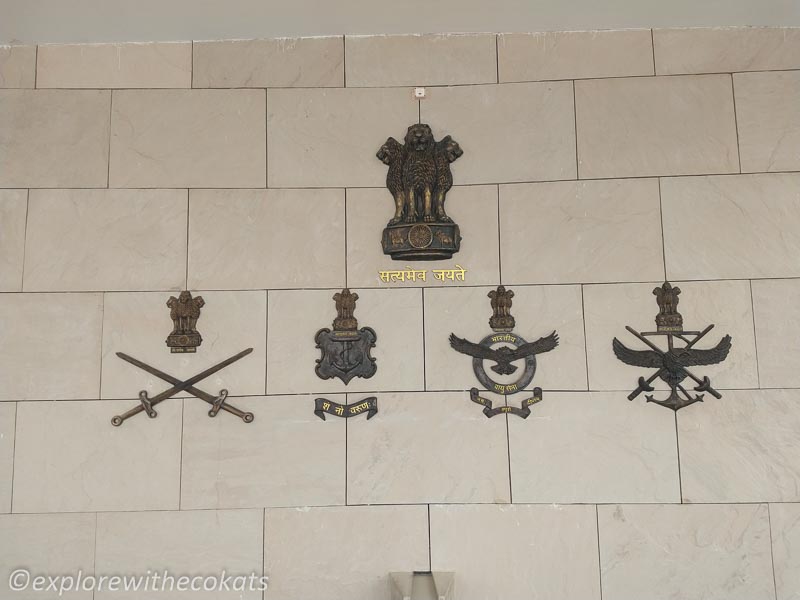
Where is National War Memorial?
National War Memorial is located in the same compound as India Gate in New Delhi.
Due to the ongoing construction of the Central Vista Redevelopment Project, the entrance to India Gate and National War Memorial is separate. And sadly, there are no parking spots around. You can be dropped off at the nearest entry gate.
My Visit to National War Memorial, New Delhi
After my visit to Agrasen ki Baoli, I headed to the National War Memorial. We circled twice in the area to figure out the entry gate. And finally, we were able to.
We were dropped off at the entry gate and from there we were guided to talk to an officer. The officer patiently waited for my family and after he had our attention gave a small introduction.
He informed us that India Gate acts as a memorial to 90,000 soldiers of the British Indian Army who died between 1914 and 1921, especially during World War I. The National War Memorial pays tribute to martyred Indian soldiers. It was inaugurated by our Prime Minister on 25th February 2019.
He guided us to start with the Param Vir Chakra section. The section has installed bronze busts of all the 21 recipients of the Param Vir Chakra in the Param Yodha Sthal, which is a part of the National War Memorial. He also guided us to whisper if talking is necessary and asked us not to shoot videos. Photos are allowed.
We started the walk in this section which is in a huge area. Every soldier who was the recipient of Param Vir Chakra and his story is put up for visitors to read.
After this section was over, we came back to the entrance, crossed the road and entered the War Memorial premises.
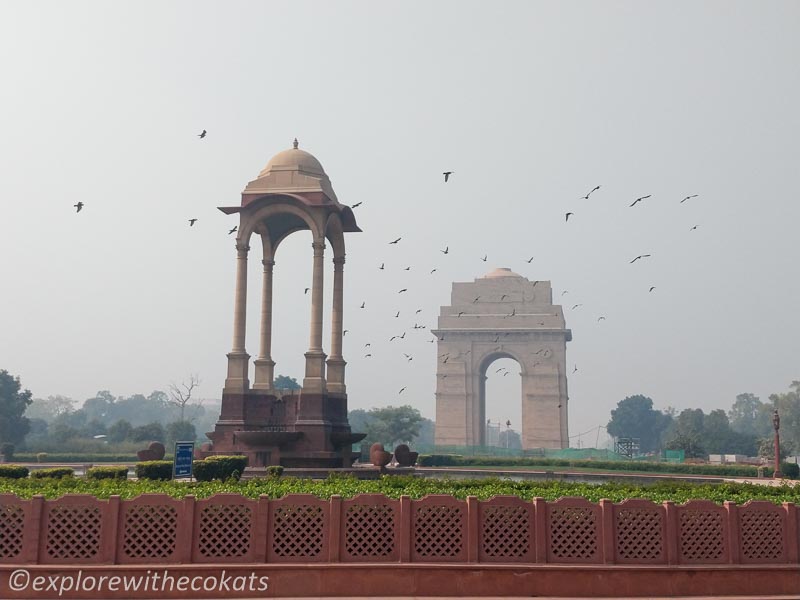
Architecture of the National War Memorial
A global architectural design competition was announced and a Chennai-based architectural firm WeBe Design Lab was declared the winner.
The sign at the entrance gives the history behind the design of the memorial. The memorial symbolizes the immortality of the spirit of the soldier and celebrates his indomitable courage. The concept of the National War Memorial is based on four concentric circles, which characterize the journey of a soldier from birth to martyrdom.
Amar Chakra (Circle of Immortality): The obelisk with eternal flame symbolises the immortality of the spirit of a soldier with an assurance that the Nation will never forget their sacrifices.
It is the centre point of the Memorial. It is a 15.5-metre tall tower with the National Emblem of India which has the eternal flame (the first eternal flame being at India Gate which was recently merged here.
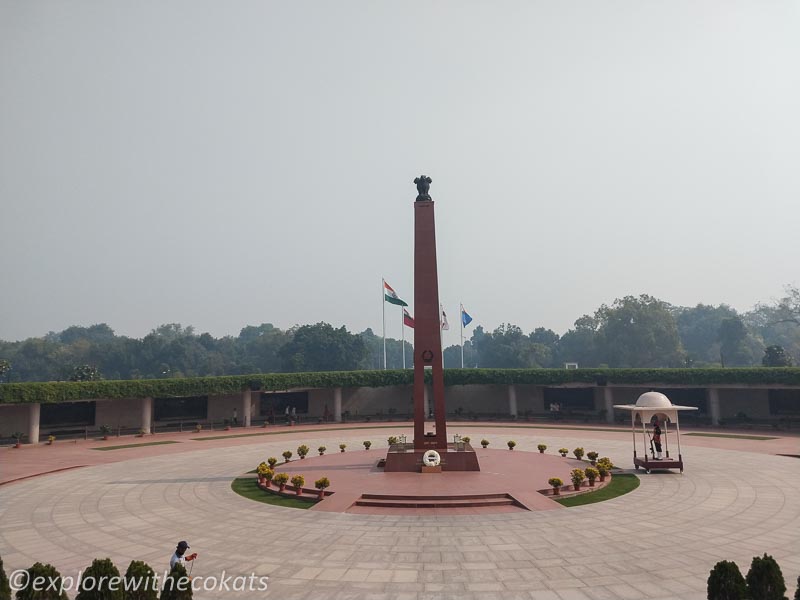
Veerta Chakra (Circle of Bravery): A covered gallery that exhibits the valiant acts of our Armed Forces during operations represented through bronze murals.
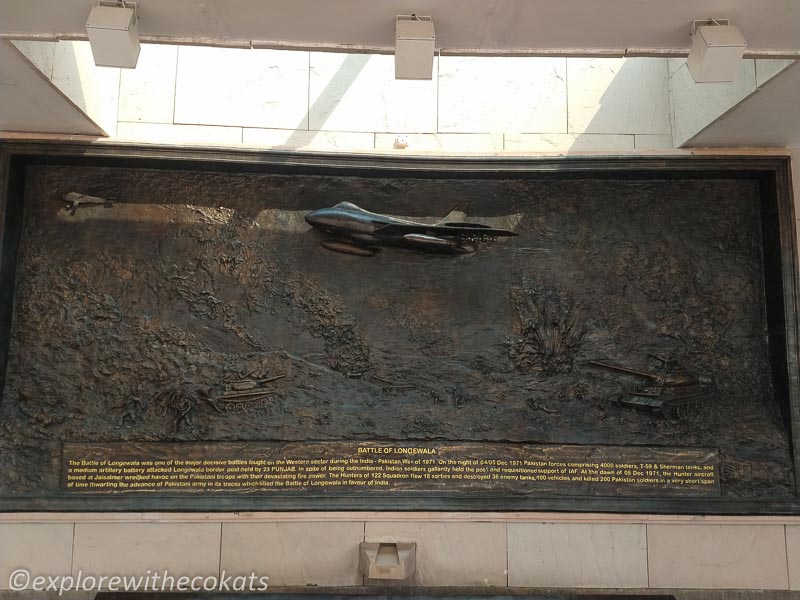
Tyag Chakra (Circle of Sacrifice): The names of 29,760 soldiers who made the supreme sacrifice are inscribed in golden letters on granite tablets arranged in a circular pattern which symbolizes the ancient war formation ‘Chakravyuh’.
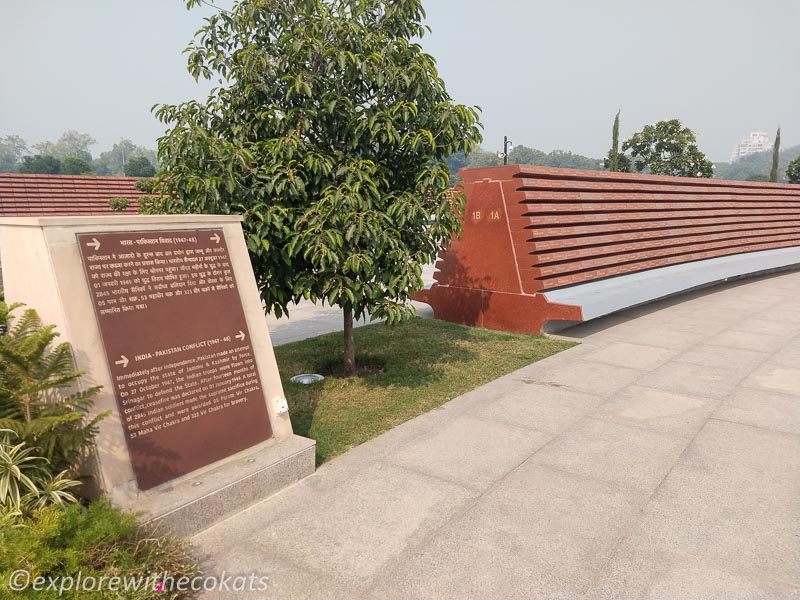
Rakshak Chakra (Circle of Protection): The row of dense trees in the Rakshak Chakra is a reassurance to the citizens of the country about their safety against any threat with each tree representing many soldiers wh guard the territorial integrity of the Nation around the clock.
Retreat Ceremony at National War Memorial
A ‘retreat’ ceremony takes place every evening wherein the flags of the Indian Army, Navy, Air Force and the national flag are slightly lowered before sunset.
‘Next-of-kin’ Ceremony
The ‘next-of-kin’ ceremony is one where a family member of a soldier who died in the line of duty is present at the National War Memorial and he/she lays a wreath at the Amar Chakra.
Change of Guard Ceremony
The Defense services namely Army, Navy and Air Force share all the duties at the War Memorial and divide the responsibilities among themselves. The duties are passed on weekly from Army to Navy to Air Force. This is called the ‘Change of Guard’ ceremony.
A guard (soldier) stands by the flame day and night.
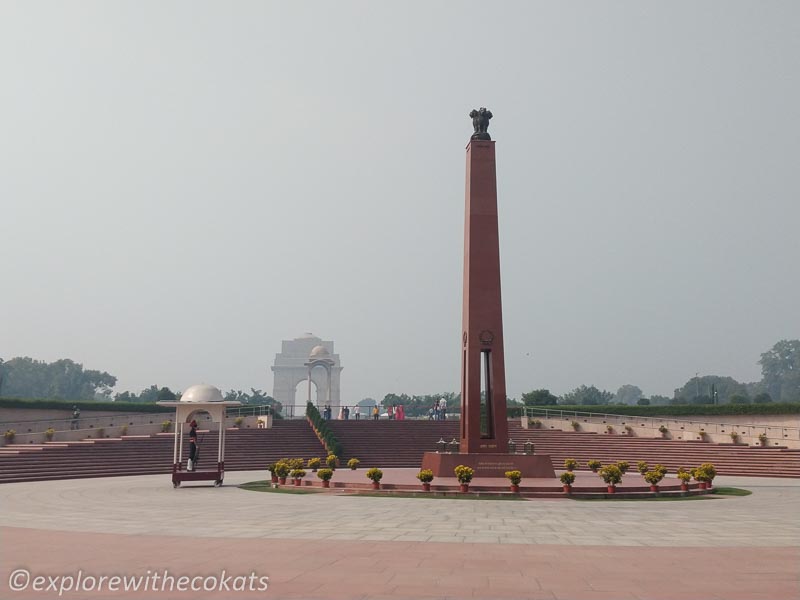
National War Memorial Mobile App
NWM App has many features incorporated such as multilingual interaction in 21 regional languages to facilitate easier comprehension for visitors from all over the country, user-friendly features for differently-abled persons, creation and integration of 166 Bluetooth Beacons for location and live mobile mapping with a virtual tour guide, audio commentary in 21 languages providing information on various battles/ wars, search facility to locate individual names amongst 26,368 battle casualties, online quizzes/ events and provision for online donations to Armed Forces Battle Casualties Welfare Fund.
Paying a virtual tribute
The complex has four digital screens. They provide information to visitors and also facilitate paying virtual tribute through the Augmented Reality (AR) feature which incorporates the provision of virtual photographs with Battle Casualties, Roll of Honour of Battle Casualties and OTP-based registration of visitors.
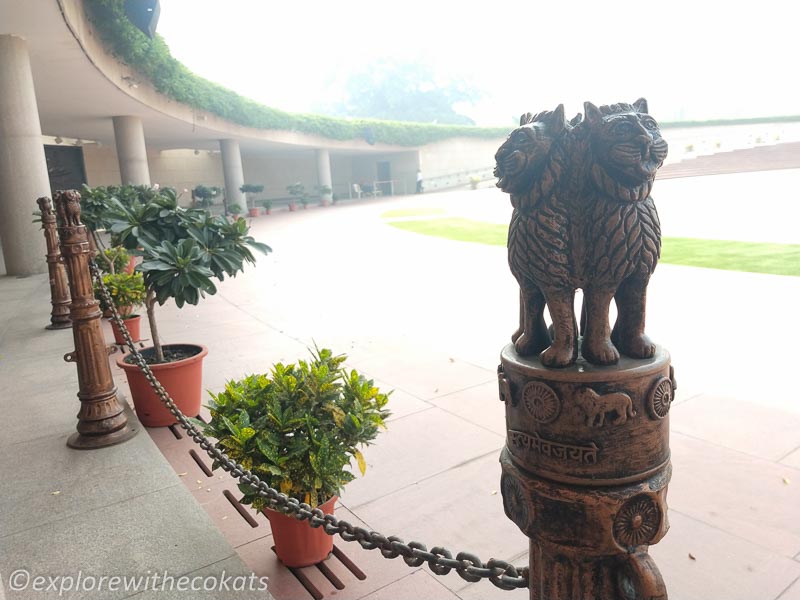
How to Reach National War Memorial
By Metro, the National War Memorial can be reached from Central Secretariat, Janpath, Udhyog Bhawan, Mandi House, Khan Market and Pragati Maidan Metro Stations. All these metro stations are located within the range of 2-3 kilometres and auto-rickshaws and taxis are available to reach National War Memorial.
National War Memorial Entry Fee
The entry is free to all
Best time to visit National War Memorial
The War Memorial opens at 9 am every day and closes at 7:30 pm in winter and 8:30 pm in summer. Evenings are the best time to enjoy the lighting scheme and watch the ‘Retreat drill’ that takes place every day. On Sundays, visitors can witness the ‘Change of Guard Ceremony’ and band display before the Retreat Drill.
Read more articles on Delhi here:
Disclaimer – This post contains affiliate links. It means it adds no extra cost to you if you book through the link but I get a referral bonus which helps me earn a little to keep this website up and running.
Pin this post!
